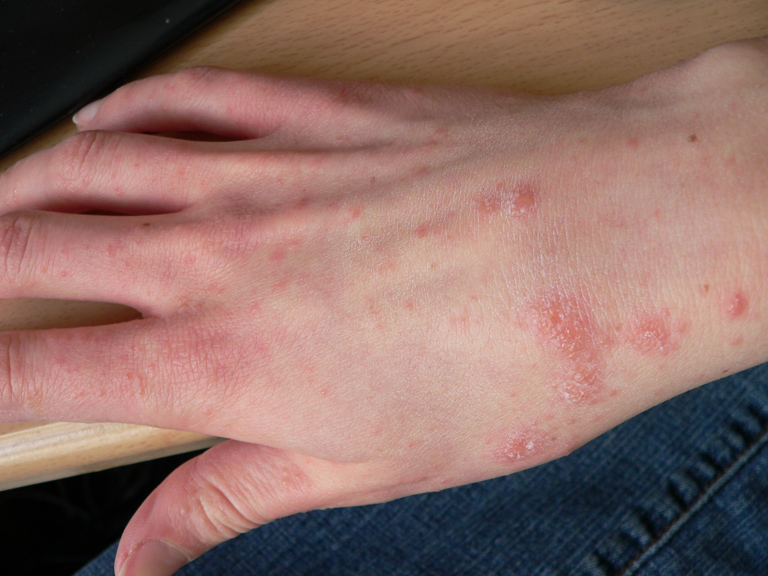Scabies
Report a Case
Disease Reporting Line:
(808) 586-4586
About This Disease
Scabies is a parasitic infection of the skin caused by a mite, Sarcoptes scabiei. The mites burrow under the skin to live and lay eggs which causes intense itching, especially at night. There are two different types of scabies, crusted and non-crusted. Crusted (Norwegian) scabies is the severe form of scabies that can occur in people who have a weak immune system, are elderly, disabled, or debilitated.
Signs and Symptoms
The most noticeable symptom of scabies is the intense itching it produces. The itching is most noticeable at the skin surface between the fingers, around the wrists, elbows or knees, armpits, nipples, belt line, abdomen, genitals (sex organs), and lower buttocks. A pimple-like rash can also develop. Symptoms take about 2 to 4 weeks after being infected. For those who have had scabies before, it can take only 1 to 4 days for symptoms to appear. Infants and very young children often have symptoms that involve the head, face, neck, palms, and soles.
Symptoms of crusted scabies are thick crusts of skin that contain large numbers of mites and eggs. People with crusted scabies may not show the usual scabies symptoms of the rash and itching.
Transmission
Transfer of parasites commonly occurs through prolonged direct contact with infested skin and also during sexual contact. Contact must be prolonged (a quick handshake or hug will usually not spread scabies, unless it is crusted scabies). Infestation is easily spread to sexual partners and household members. Infestation may also occur by sharing clothing, towels, and bedding. Transfer from undergarments and bedclothes occurs only if these have been contaminated by infested people immediately beforehand. Less than 10–15 mites can be present on a person who appears healthy and has no symptoms.
People with crusted (Norwegian) scabies are very contagious and can spread the infection easily by direct skin-to-skin contact and by contaminating items such as clothing, bedding, and furniture. Within the crusts, there can be thousands of mites and eggs.
Diagnosis
Your doctor can diagnose scabies from your clinical symptoms, appearance and distribution of rash and presence of burrows. When possible, the physician will confirm the diagnosis by identifying mite, eggs, or fecal matter from the burrow by microscopic examination. A person can still be infested even if mites, eggs, or fecal matter cannot be found.
Treatment
A mild case of scabies is treated with a single application of a medicated skin cream or lotion prescribed by your doctor. This is followed by a hot water bath and soap. The itching is caused by the body’s reaction to the mite. Because itching may continue for days or weeks after adequate treatment, it should not be used as an indication that the medication did not work. It is recommended that all members for the same household and sexual partners should be treated at the same time.
The recommended treatment for crusted scabies is an oral and topical medication prescribed by your doctor. Close contacts, including household members, of those infected with crusted scabies should be treated as well, to prevent outbreaks.
Washing clothing, towels and bedding in hot cycles of both the washer and dryer will kill mites and eggs. Also, thorough vacuuming of environmental surfaces is recommended. This should be done at the same time that you treat scabies with medication.
Risk in Hawaii
There are no statistics on how many people have been infected with scabies in Hawaii. Scabies is easily passed from an infested person to their household members or sexual partners. Scabies in adults is frequently acquired sexually.
Prevention
Avoid direct skin-to-skin contact with an infested person. Be sure to wash clothing and bedding with hot water and dry with high heat or dry clean. Scabies mites generally do not survive more than 2 to 3 days away from human skin. Children and adults can return to work or school the day after treatment.
Close contacts of people with crusted scabies should be treated at the same time to avoid an outbreak.
Information for Clinicians
Centers for Disease Control and Prevention (CDC)
Scabies in Institutional Settings | CDC
General Guidance for the Outbreak Detection and Reporting of Scabies, The Council for Outbreak Response Healthcare-Associated Infections and Antimicrobial Pathogens | CORHA
Infection Prevention in Long Term Care Scabies, Massachusetts Department of Public Health (PDF)
Scabies Protocol, Federal Bureau of Prisons Clinical Guidance (PDF)
Last Reviewed: June 2024



